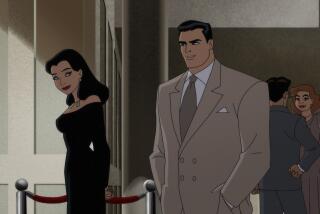A New Dimension to Arcade Games : Time Traveler Introduces 3-D Action to Lure Coins From Players’ Pockets
- Share via
Like any good arcade, the sprawling “family entertainment center” at the Vallco mall in Cupertino, Calif., offers plenty of ways to spend a quarter. There are all the old standbys--from pinball to ski ball to the metal crane that grapples for prizes--as well as a carousel, a batting cage and an extensive lineup of video games.
But for Sean Grissom, a 22-year-old from nearby Sunnyvale, all of these diversions are passe compared to the newest sensation in coin-operated entertainment, a novel mixture of Hollywood and high technology called a holographic game.
Hunched over the familiar joystick and control buttons, Grissom maneuvers an amazingly lifelike, 3-inch-tall gunslinger that struts about a miniature stage, fighting off Ninja warriors, street punks, zombies and a host of other B-movie villains.
“This is a lot better than any of the other games,” Grissom said enthusiastically. “You can really get involved with it. I couldn’t see spending my quarters on anything else.”
That’s music to the ears of Sega Enterprises, which spent about $2 million developing the “Time Traveler” game, to be rolled out nationally this week after pilot introductions at a number of arcades.
And if other video game buffs share Grissom’s enthusiasm, a new breed of games using this technology could provide a spurt of growth for the coin-operated entertainment business, a volatile, $7-billion-a-year industry that’s rich in history and exceptionally sensitive to cultural fads and technological change.
“The entire arcade industry has been avidly looking for new technology,” said Marcus Webb, editor of a Woodland Hills-based trade magazine called (what else?) Replay. “There’s a lot of excitement about this among distributors and arcades.”
The secret behind Time Traveler’s eerie 3-D images is a mirror-like optical device developed by the Japanese firm Dentsu. When placed in front of a video monitor, the optic reflects the picture upward, and it appears as a three-dimensional optical illusion hovering in space.
This trick is combined with a laser disc, which contains hundreds and hundreds of separate film clips representing each scene and each movement made by the different characters. Thus when a player pushes the joystick to move left and duck, the laser disc instantly retrieves the clip where the cowboy moves left and ducks, then displays it on the hidden video monitor for instant conversion into a 3-D image.
The game’s visceral appeal comes from its use of laser disc video, which allows the player to manipulate costumed actors and actresses rather than the animated figures normally found in video games. Indeed, when the cowboy--played by Anaheim actor Steve Wilbur--isn’t quick enough on the draw and gets stabbed or strangled or bludgeoned by one of his adversaries, it looks every bit as real and grisly as, well, death in the movies.
“I’m still recovering from some of the falls,” said Wilbur, who was originally recruited as the stunt coordinator for the low-budget shoot and was then handed the starring role. He agreed that some of the death scenes are a bit graphic, but noted that the game also has an anti-drug message.
That doesn’t soothe Carole Lieberman, a Los Angeles psychiatrist who has long sounded the alarm over the impact of violent entertainment on children. She said increasingly realistic and interactive depictions of violence were only making the problem worse.
Ethical issues aside, the “coin-op” business has high hopes for Time Traveler in particular and 3-D and laser disc games in general. Like the movie industry, the game business is heavily dependent on big hits, and there hasn’t been a real blockbuster since Pac Man in the early 1980s.
Laser disc games introduced in the mid-1980s were popular but hopelessly unreliable, and big “simulation” games that put the player in a driver’s seat may have run their course.
Moreover, the relative complexity of Sega’s technology offers a big advantage for arcade operators: It won’t be replicated on home video game machines any time soon.
“Amusement center operators want to offer something that people can’t play for free,” said Ira Bettelman, president of B. A. Robinson & Co., the biggest arcade game distributor in the Southland.
The whole history of the coin-op business, in fact, revolves around just that principle. According to Webb of Replay magazine, the first arcades were listening parlors where customers could deposit a nickel to hear a song from a jukebox. But when the Victrola, the first mass-market record player, appeared in 1907, the arcade operators had to find new novelties.
First they moved to a hodgepodge of attractions including mechanical games of skill, strength testers, scales and even fortune tellers. Then, in the 1920s, the so-called redemption games, such as the grappling crane, were all the rage in the arcades, while manufacturers made plenty of money putting jukeboxes in bars and restaurants. Pinball started to take off with the introduction of flippers in the 1940s.
But it was the electronic tennis game called Pong, introduced in the early 1970s, that ushered in a whole new era for the coin-op industry. The Pong craze was short-lived, but it was followed quickly by Space Invaders and Asteroids, and finally, in 1980, by Pac Man.
Coin-op revenues exploded from about $1 billion annually in the pre-video era to more than $7 billion, before falling back in the mid-1980s and then recovering again, Webb estimated. Industry executives say sales have been off since the recession began, but now appear to be making a comeback.
Today, video games represent about half of industry revenues, according to Joe Dillon, vice president of sales at Williams Electronics, the largest manufacturer of arcade games. Redemption games are making a comeback with the advent of big family-oriented arcades such as the one at the Vallco Mall.
More to Read
The biggest entertainment stories
Get our big stories about Hollywood, film, television, music, arts, culture and more right in your inbox as soon as they publish.
You may occasionally receive promotional content from the Los Angeles Times.










